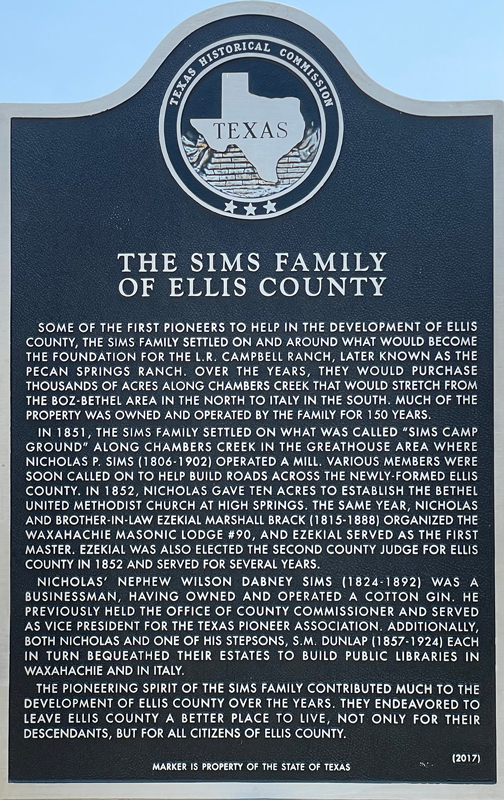I. CONTEXT
Ellis County was bypassed by early Spanish and Mexican explorers in the days before the Republic. It wasn’t until 1842 that the first white person, William Ross Howe (?-1847), settled in the area on the banks of Chambers Creek.1 The area was still sparsely populated in 1849 when records show that it took two tries to find the requisite 100 signatures of persons living in the area to sign a petition to form Ellis County from Navarro County.2 The first census taken in the county in 1850 recorded only 989 people living in the entire county,3 so when the Sims family migrated from Mississippi in 1851, they were truly some of the first pioneers to help in the development of the new county. When the Sims family came to Ellis County, several members of the family settled on and around what would become the foundation for the L.R. Campbell Ranch, later known as the Pecan Springs Ranch, on Chambers Creek. They would own and operate the land for over 150 years.
II. OVERVIEW
The Sims was an old Virginia family, moving to Maury County, Tennessee in the early 1800s. About 1833, the family migrated to Lafayette County, Mississippi,4 where they were prosperous farmers owning substantial real estate5 and many slaves.6 In 1851, several members of the extended Sims family relocated to Ellis County, first settling along Chambers Creek in the Greathouse area. Over the years, they would purchase thousands of acres along the creek that would stretch from the Boz-Bethel area in the north to Italy in the south.7 They brought with them their farming practices and their slaves, as well as their social and religious institutions.
Wilson Dabney Sims (3 October 1824-10 May 1892) was only 27 years old when he came to Texas with his father John Dabney Sims (3 October 1802-April 1878) and mother Elizabeth (1804-February 1880), his uncle Nicholas P. Sims (15 August 1806-24 May 1902), and his aunts Lucy Sims Brack (13 March 1814-13 March 1886) with her husband Ezekial Marshall Brack (13 January 1815-1 November 1888), and Mariah Sims (13 March 1809-17 September 1882) who never married.8 1852 Ellis County Commissioners Court records suggest that together the family purchased and settled on what was called “Sims Camp Ground”9 in the Greathouse area where Nicholas operated a mill on Chambers Creek,10 and various members of the Sims family were called on as either overseers or hands to build roads across the newly formed county.11
Within a year of arrival in Ellis County, various members of the Sims family had already become influential in developing the community. In 1852, Nicholas gave 10 acres to establish the Bethel United Methodist Church first at High Springs just a few miles west of the present church.12 Many members of the Sims family continue as members of the church, and a Sims descendant, Heath Sims, currently serves as pastor. In the same year, Nicholas and Ezekial Brack were instrumental in organizing the Waxahachie Masonic Lodge #90, and Ezekial served as the First Master.13 Ezekial was also elected the second county judge for Ellis County in 1852 and served in that capacity for several years.14
While Ezekial and Lucy Sims Brack continued to live and raise their family in the Greathouse area, John Dabney (J.D.) Sims purchased land farther south. In 1856 Lewis B. DeSpain (1821-10 July 1854) had received a land grant for 640 acres in 1839,15 but no records show that he ever lived on or visited the property, and after his death, J.D. purchased it from DeSpain’s former wife and husband at public auction.16 The southern half of what is known as the L.B. DeSpain survey comprises the northern section of the current Pecan Springs Ranch. It is this property that remained under Sims family ownership for 150 years.
By 1860, all members of the Sims family were prosperous farmers, stockmen, and land owners in Ellis County. Ezekial and Lucy owned about 1,000 acres of mostly unimproved land and ran 375 head of cattle and 450 head of sheep, while Nicholas owned approximately 1,000 acres raising 500 head of sheep which produced 1,300 pounds of wool and farmed wheat, rye, and Indian corn. J.D. owned 2,200 acres of land producing 4,000 bushels of wheat and 2,500 bushels of Indian corn, in addition to raising 100 sheep which produced 572 pounds of wool. His son, Wilson Dabney (Dabney), who continued to live with his parents until after the Civil War, was beginning to purchase his own property and now owned approximately 900 acres, most of which was unimproved land.17 In addition, Ezekial owned two slaves, Nicholas owned six slaves, and J.D. owned 24 slaves who contributed to their labor force.18
Although members of the Sims family were slave owners, they evidently treated them well. “When slaves were emancipated in 1865, most had no last name and many took the surname of the former masters. Among the slaves who had belonged to John Dabney Sims were ‘Ole Aunt’ Hannah Sims, and her husband Aaron, [and] their sons Gilbert (21 October 1844-29 October 1926) and Ben Sims (1851-1922) [and others]. Following emancipation, most of them remained in the Italy/Milford area of Ellis County.”19 Almost 30 years later in 1892, it was Gilbert Sims that organized the Sims family reunions that brought together the former slaves of John Dabney Sims and their descendants, and relatives of J.D. Sims. These reunions continued through at least 1897 and were held on the old Sims homestead two and a half miles northwest of Italy.20 The reunion in July 1894 brought together 25 former slaves, 250 of their children and grandchildren, 100 Sims relatives, and 200 additional old settlers and their descendants. Former slave and Methodist preacher Anderson Brack (?-1905) “alluded to the kindness of his old master”21 in his speech. Following the Civil War, many of the former Sims slaves continued to live on and work the land as tenant farmers as evidenced by the 1870 U.S. Census.22
Unfortunately, the decade of the 1870s brought much tragedy to the Sims family. Son Wilson Dabney was 46 years old when he married his first wife Sallie High (1850-30 April 1873) in 1871. After their daughter, Sallie Marie Sims (17 May 1872-17 July 1898) was born, the mother died in 1873. He then married Sallie’s younger sister Bettie High (?-1879) who died after only four years of marriage having given birth to two more daughters, Bessie Tilden Sims (7 November 1876-1 November 1891) and Louella Sims (15 June 1878-15 November 1955). In April 1876, Nicholas lost his wife of 44 years, Amanda Zollicoffer Sims (February 1813-21 April 1876), and in April 1878, W.D.’s father John Dabney Sims died.23
Life for Nicholas had taken a change. He was 70 years old and childless, but found love again in 1877 when he married his first cousin, Eliza Harlan Cross Tannehill Dunlap (16 April 1814-15 June 1897). It was her fourth marriage and she had recently moved to Ellis County.24 With no heirs, Nicholas began to sell some of his property and disengage in farming. In 1869, he had purchased 640 acres farther south along Chambers Creek that comprised the Charles Merlin survey for $1,000 gold.25 The Merlin survey is one of the earliest land grants in Ellis County and one of the few signed by President Sam Houston.26 It lies just south of the L.B. DeSpain survey and borders the William Ross Howe property, once called Howe’s Settlement for its first settler, and later renamed Forreston, for Capt. Hardeman Carr Forrest (9 September 1826-5 May 1909) who married J.D. Sims’ daughter Virginia (11 December 1837-22 February 1868).27 When J.D. Sims died, he bequeathed to his son Dabney the L.B. DeSpain property and $2,500 in gold28 which he used to purchase the Charles Merlin property from his uncle and aunt, Nicholas and Eliza Sims.29 It is these two properties that made up the nucleus of the Wilson Dabney Sims farm and the future Pecan Springs Ranch. In all, Dabney conducted approximately 30 property purchases totally over 2,800 acres after his father died.30
In March of 1880, Dabney married for the third and final time. Evelyn Watkins Whitfield (9 November 1849-20 December 1911) was 25 years younger than Dabney, and they had three children: Minnie Evelyn Sims (10 December 1880-28 November 1959), Wilson Dabney Sims Jr. (11 January 1883-8 October 1956), and Patrick Whitfield Sims (25 July 1887-3 October 1936).31 It was on the Merlin property that Dabney chose to make a home for his family.
Since water was the key to survival in those days, Dabney established a headquarters at a spring in a remote area on the property and built a house for his family which house still stands…A row of houses for the [tenant farmers] was built on the other side of the draw from the main house. They were built in a straight line and became known as Stringtown…In those days transportation was by horse or mule only and since the home was in a remote area with only mud roads, access to the outside world was limited…so a tutor lived with the family when the children were young.32
By the time of his death in 1892, Wilson Dabney Sims had also made his mark in the development of Ellis County. He had owned and operated a cotton gin, was a director of the First National Bank of Waxahachie, and owned residences and business houses in Waxahachie, Italy, and Milford. He had previously held the office of County Commissioner33 and served as a vice-president representing Ellis County for the Texas Pioneer Association organized in Fort Worth along with his brother-in-law Capt. Carr Forrest.34
Dabney’s will provided for his holdings to be divided among his wife Evelyn and the his five living children: Sallie, age 19; Louella, age 14; Minnie, age 12; Wilson Dabney Jr. (W.D.), age eight; and Patrick, age five. Daughter Bessie had died at age 16 less than six months before her father. A statement in Dabney’s will showed his love for the land: “They cannot better show their appreciation of these my bequests than by taking care of same and by industry adding thereto and preserving in the family not only the property, but a good name.”35
Dabney Sims died only months before the first reunion was held for former Sims slaves and those who had brought them to Texas. By 1896, Nicholas, age 90, was the only one of the original Sims family still living and attending the reunions. Former slave Anderson Brack praised Nicholas and his family for not treating them as slaves and told the story of a time when Nicholas had given “one of his servants $500 at one time, and he wasn’t under any obligation to either.”36 Only one year later, Eliza Dunlap Sims died in 1897 after twenty years of marriage to Nicholas,37 and on 24 May 1902, the last of the early Sims pioneers died. Nicholas P. Sims would leave a lasting legacy to the citizens of Ellis County. In his will he provided:
I am without descendants and have spent the best years of my life in Ellis County, Texas where I have accumulated the bulk of my fortune and am desirous of promoting the mental, moral and physical advancement of said county and city of Waxahachie, its county seat, and especially of the youth…[I] bequeath the residue of my estate…in trust for the establishment and maintenance of a public library and lyceum in the city of Waxahachie…to be known as the N.P. Sims Library and Lyceum.38
The Dallas Morning News paid high tribute to the last of the Sims pioneers in his obituary: “He was a man of position and decided character…He had the highest integrity. Honesty and morality was Nicholas P. Sims.”39 The formal dedication for the library was held in 1905 and the Waxahachie Daily Light commended the farsightedness of its founder. Nicholas Sims’ will was “a very remarkable instrument in that it made provision for the establishment, maintenance and government of the institution for the present and the future”40 making it “one of the first ten public libraries and one of the first privately owned libraries in Texas.”41 The library has been in continuous operation for over 110 years.
Although Nicholas had no children of his own, he was very close to his two stepsons, Judge Oscar E. Dunlap (30 November 1849-30 August 1925) and Samuel Meriweather Dunlap (10 April 1857-24 April 1924), who he had named trustees of the library along with his nephew George Henderson Cunningham (8 January 1828-6 April 1916) who had married J.D. Sims’ daughter Tennessee (28 November 1840-14 August 1913).42 And although Nicholas cannot be credited totally, he no doubt inspired S.M. Dunlap’s decision to also create a library. When he died in 1924, his will provided for the bulk of his estate to be used to build a public library in the city of Italy, Texas. The S.M. Dunlap Memorial Library is the “only fully endowed library in the state.”43
The influence of the Sims family in Ellis County continued even after the death of its pioneer ancestors. Dabney Sims’ youngest son Patrick had inherited the Sims family farm, part of which is now the Pecan Springs Ranch, after his mother Evelyn’s death in 1911,44 and himself made a cultural contribution to the citizens of the county. Well-known band leader James E. King (25 January 1885-25 July 1947) came to Waxahachie in 1915 and reorganized the Lone Star Band with the assistance of Patrick. King served as the bandmaster, while Patrick was the sponsor and bass drummer. Two years after its re-organization in 1917, the 150-member all-male band played in Washington, D.C., for President Woodrow Wilson. “When the United States entered World War I in the same year, seventy-five bandsmen left for the service. The Lone Star Band provided more musicians for military bands than any other band in the nation…Although the war had taken some of its members, the Lone Star Band in 1918 was chosen the official band for the ex-Confederate Convention”45 traveling all over the United States for concerts and contests, serving as the ambassador of Waxahachie to the nation.
When Patrick, who never married, died suddenly and without heir in 1936, his estate was divided between his three siblings, with his sister Minnie Sims Campbell (10 December 1880-28 November 1959) inheriting that portion46 they named the L.R. Campbell Ranch for her husband, Lee Robert Campbell (7 October 1883-30 August 1960) who farmed and ranched on the property until his death in 1960. The rural road frontage for the property was officially named L.R. Campbell Road in 1991 for the last owner of the Campbell Ranch who farmed the land.47 Minnie and L.R.’s only son, William Dabney Campbell (19 December 1909-12 December 2008), had married and moved to Amarillo following his service in World War II, where he spent the remainder of his life,48 returning to the ranch he inherited from his parents only for visits.49
Before his death, William had granted the ranch in 1991 to his four children: William D. Campbell Jr., Patricia Campbell Johnson, Ward Gannon Campbell, and Priscilla Campbell Snow.50 It wasn’t until 2008 when William’s children sold the former L.R. Campbell Ranch comprised of the L.B. DeSpain survey and the Charles Merlin survey, that the property passed from Sims family ownership,51 marking 150 years of ownership on the DeSpain property and over 130 years for the Merlin property. Today, the property is owned by Ted and Nancy Paup of Fort Worth52 who have renamed the acreage Pecan Springs Ranch. Even with its new name, the ranch recalls the Sims family legacy—named for the springs on which the Dabney Sims homestead was built and a pecan grove on the ranch.53 Dabney’s son, Wilson Dabney Sims Jr. had been a pecan specialist with the Texas Department of Agriculture and was “recognized as one of the best posted authorities on pecan growing in Texas.”54
III. SIGNIFICANCE
The pioneering spirit of the Sims family contributed much to the development of Ellis County over the years from serving as elected officials to building roads and from establishing churches and cultural institutions to developing its agricultural resources. They saw the needs of a fledgling county and its people and they met the challenge, dealing fairly with all they met, whether they were free or slave. They endeavored to leave Ellis County a better place to live, not only for their descendants, but for all citizens of Ellis County. They left, however, more than a lasting legacy for the county…they left a good name as well. District Judge Alexander Royce Stout (27 February 1900-16 January 1984) once wrote in the book History of Ellis County, Texas that Wilson Dabney Sims was in the company of the kind of men who were “influential in all things, both political and otherwise, because of the example they have furnished by the kind of life they have lived…but they have lived for the betterment of their community and have helped make it and all about it a finer place in which to live.”55
Many thanks to Ms. Sharan Farmer, B.A., for her historical research contributions about Pecan Springs Ranch and Ellis County. Ms. Farmer submitted the narrative for The Sims Family to the Ellis County Historical Commission and the Texas Historical Commission.
IV. DOCUMENTATION
1 Lavender, James A. The Early Settlement of Ellis County and a Biographical Sketch of the William R. Howe Family. Dallas: n.p., 1941. Granville D. Edwards and Patrick Howe Edwards, 2011. Print. pp. 14-15, 19.
2 “Ellis County, It’s Early Settlers and Organization.” Daughters of the American Revolution. Rebecca Boyce Chapter (Waxahachie, Tex.). Genealogical Records Committee. Texas Genealogical Records, Ellis County, Volume 4, 1790-1955. University of North Texas Libraries, The Portal to Texas History. Web. 11 April 2016. p. 4.
3 Ellis County Historical Commission. “Early Settlement and Organization.” Rootsweb. N.d. Web. 1 February 2016.
4 Farmer, Michal Martin. William Sims born, say, 1655, will made 18 December 1710, James City County, Virginia and his Descendants. Michal M. Farmer, 2011. Web. 28 January 2016. p. 89.
5 Ancestry.com. 1850 United States Federal Census [database on-line]. Provo, Utah: Ancestry.com Operations, Inc., 2010. Web. 19 February 2016.
6 Ancestry.com. 1850 U.S. Federal Census Slave Schedule [database on-line]. Provo, Utah: Ancestry.com Operations, Inc., 2004. Web. 20 February 2016.
7 Farmer, p. 90; Fox, Mary Sondra Horne. The Sims Family: From Virginia to Texas. N.p: n.p., August 2012. Print. p. 56.
8 Fox, n.p.
9 Ellis County Commissioners Court minutes, Vol. 1, 1850-1857. Print. p. 70.
10 “Greathouse Community.” Ellis County TXGenWeb hosted by Rootsweb, 2002. Web. 12 June 2015.
11 Ellis County Commissioners Court minutes, p. 84.
12 Ellis County Deed Records, Vol. A. Print. p. 127.
13 Elliott, Mary Frances Hampton and Frances Dunaway McGregor. “History of Bethel Church, the Tabernacle and Parsonage.” Searchers and Researchers, Ellis County, Vol. 32, Issue 1. Spring 2009. Print. p. 29.
14 Ellis County Commissioners Court minutes, p. 64.
15 L.B.D. Spain Abstract #969. Texas General Land Office. Land Grant Database. Digital images. Web. 14 January 2016.
16 Ellis County Deed Records, Vol. C. Print. p. 86-88.
17 Ancestry.com. Selected U.S. Federal Census Non-Population Schedules, 1850-1880 (1860 Agricultural Schedule) [database on-line]. Provo, Utah: Ancestry.com Operations, Inc., 2010. Web. 19 February 2016.
18 Ancestry.com. 1860 U.S. Federal Census - Slave Schedules [database on-line]. Provo, Utah: Ancestry.com Operations Inc, 2010. Web. 19 February 2016.
19 Fox, n.p.
20 Fox, n.p.
21 “Unique Reunion, Italy, Ellis County, Texas, July 27.” Dallas Morning News. Dallas, Texas, 28 July 1894, p. 3. Published by Michal Farmer, 2011. Web. 21 May 2015.
22 Ancestry.com. 1870 United States Federal Census [database on-line]. Provo, Utah: Ancestry.com Operations, Inc., 2010. Web. 19 February 2016.
23 Farmer, pp. 87, 102, 244.
24 Cross, Clinton F. Eliza Sims and Two Libraries: A Family History. rev. 2013. Published by Magnolias and Peaches, p.19. Web. 28 January 2016; “Wedded at Last.” Jasper Weekly Courier. Jasper, Indiana, 18 January 1878. Published by Hoosier State Chronicles. Web. 29 January 2016.
25 Ellis County Deed Records, Vol. I. Print. p. 414.
26 Ellis County Deed Records, Vol. E. Print. p. 163.
27 Ellis County Historical Commission. “Early Settlement and Organization.”
28 “Will of John D. Sims.” Typed copy in N.P. Sims Library, Waxahachie, Texas. Print.
29 Ellis County Deed Records, Vol. S. Print. p. 78-79.
30 Ancestry.com. Selected U.S. Federal Census Non-Population Schedules, 1850-1880 (1880 Agricultural Schedule) [database on-line]. Provo, Utah: Ancestry.com Operations, Inc., 2010. Web. 25 February 2016.
31 Farmer, pp. 244, 251.
32 Campbell family. “History of the Dabney Sims Ranch House.” 1994. Print.
33 Memorial and biographical history of Ellis county, Texas ... Containing a history of this important section of the great state of Texas, from the earliest period of its occupancy to the present time, together with glimpses of its future prospects; with full-page portraits of the presidents of the United States, and also full-page portraits of some of the most eminent men of the county, and biographical mention of many of its pioneers, and also of prominent citizens of to-day. Chicago: Lewis Publishing, 1892. Print. p. 253.
34 “Texas Pioneers: Old Texans Meet and Organize Texas Pioneer Association.” The Gazette. Fort Worth, Texas, 22 July 1889. Web. 15 February 2016.
35 Will of W.D. Sims, #887, 16 April 1891. Ellis County Clerk. Print.
36 “The Sims Reunion. Incidents of a pleasant gathering of ex-slaves and descendants. Italy, Texas, July 25.” Dallas Morning News. Dallas, Texas, 28 July 1896, p. 6. Published by Michal M. Farmer, 2011. Web. 21 May 2015.
37 Cross, p. 21.
38 “Will of the Late Nicholas P. Sims: Text of the Document Which Made Possible a Public Library and Lyceum in Waxahachie.” Waxahachie Daily Light. Waxahachie, Texas, 26 April 1905. Print.
39 Nicholas P. Sims obituary. Dallas Morning News. Dallas, Texas, 8 June 1902, p. 23. Published by Michal Farmer, 2011. Web. 16 February 2016.
40 “Dedication of N.P. Sims Library.” Waxahachie Daily Light. Waxahachie, Texas, 26 April 1905. Print.
41 Cross, p. 3.
42 “Will of the Late Nicholas P. Sims.”
43 Stroud, Mrs. K.G. “The S.M. Dunlap Memorial Library, Italy, Texas.” Daughters of the American Revolution. Rebecca Boyce Chapter (Waxahachie, Tex.) Genealogical Records Committee. Texas Genealogical Records, Ellis County, Volume 21, 1680-1968. University of North Texas Libraries, The Portal to Texas History. Web. 28 January 2016.
44 Will of E.W. Sims, #1533, 25 November 1911. Ellis County Clerk. Print.
45 Dorsey, Stuart. “Waxahachie Lone Star Band.” Texas State Historical Association. The Texas Historian, Volume 35, Number 2, November 1974. University of North Texas Libraries, The Portal to Texas History. Web. 5 April 2016.
46 Estate of Pat W. Sims, #3119, 9 November 1936. Ellis County Clerk. Print; Ellis County Deed Records, Vol. 338, p. 528-534. Print.
47 Roberts, Terri L. “The History of Pecan Springs Ranch.” Research project for Southwestern Assemblies of God University, Waxahachie, Texas. Spring 2015. Print. p. 35.
48 William Dabney ‘Bill’ Campbell obituary. Amarillo Globe-News. Amarillo, Texas, 15 December 2008. Published by Find-a-Grave. Web. 9 February 2016.
49 Will of Minnie Sims Campbell, #5136, 16 February 1960. Ellis County Clerk. Print; Will of Lee R. Campbell, #5223, 14 February 1945. Ellis County Clerk. Print.
50 Ellis County Deed Records [database on-line], Vol. 852, p. 804-813. Web. 18 February 2016.
51 Ellis County Deed Records [database on-line], Book 2418, p. 1168-1175. Web. 18 February 2016.
52 Ellis County Deed Records [database on-line], Book 2632, p. 1168-1178. Web. 18 February 2016.
53 Roberts, p. 36.
54 “Dabney Sims, Pecan Specialist.” Dallas Morning News. Dallas, Texas, 18 September 1937, p. 2. Published by Michal M. Farmer, 2011. Web. 16 February 2016.
55 Stout, Judge A.R. “Political History,” History of Ellis County, Texas. Waco: Texian Press, 1972. Print. p. 283.
ADDITIONAL SOURCES:
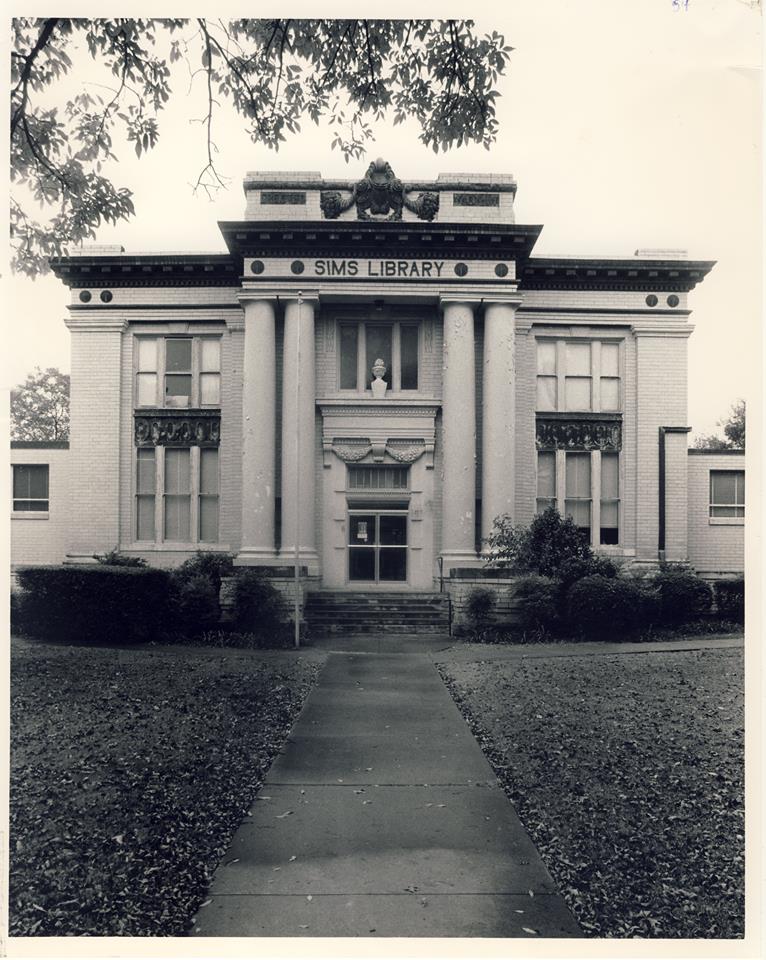
N.P. Sims Library and Lyceum
Waxahachie, Texas
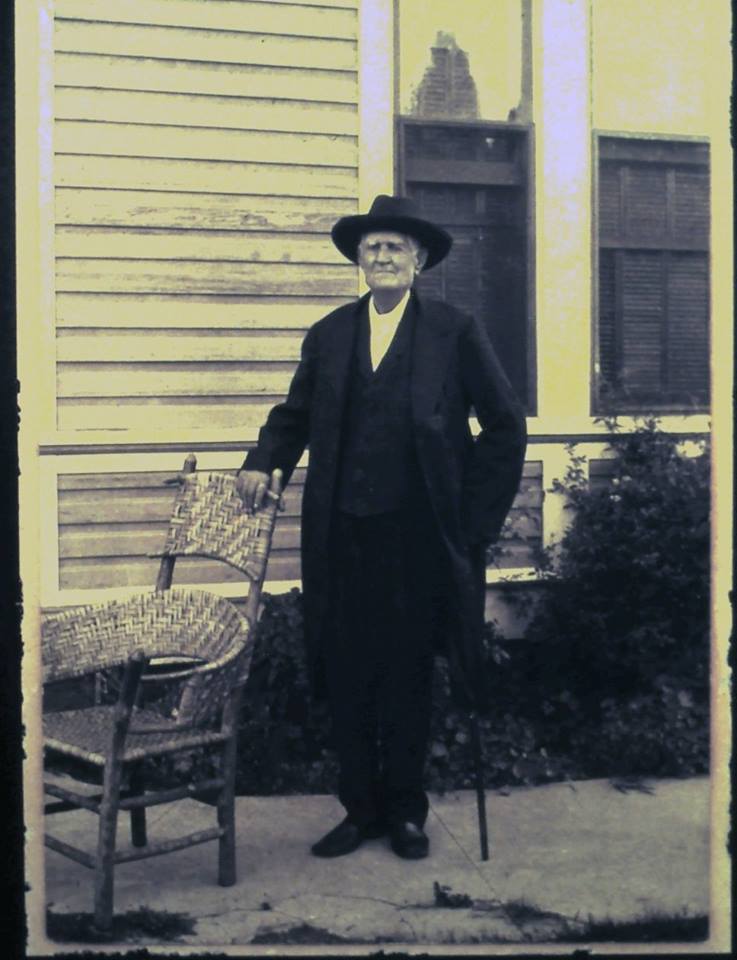
Nicholas P. Sims
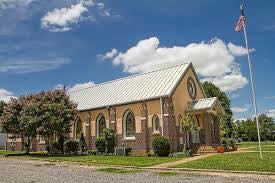
Current Bethel United Methodist Church where Sims family members continue to worship and a Sims descendant serves as pastor. Founded by members of the original Sims pioneer family.
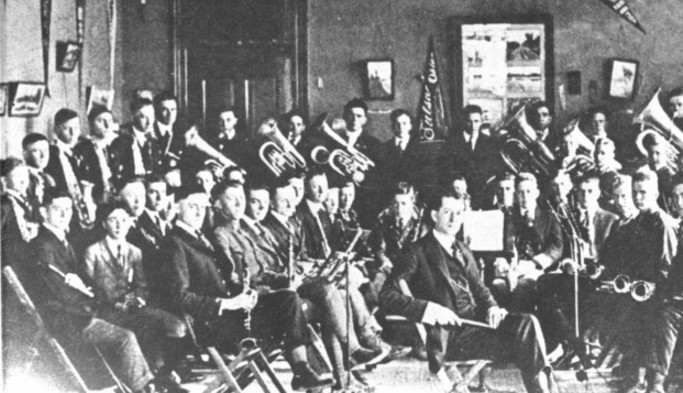
Lone Star Band of Waxahachie, Texas
